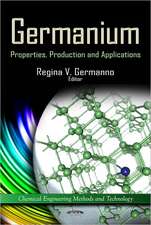Inverse Heat Conduction – Ill–Posed Problems, Second Edition
Autor K Woodburyen Limba Engleză Hardback – 2 apr 2023
Preț: 826.42 lei
Preț vechi: 908.16 lei
-9% Nou
Puncte Express: 1240
Preț estimativ în valută:
158.19€ • 171.88$ • 132.96£
158.19€ • 171.88$ • 132.96£
Carte tipărită la comandă
Livrare economică 21 aprilie-05 mai
Preluare comenzi: 021 569.72.76
Specificații
ISBN-13: 9781119840190
ISBN-10: 1119840198
Pagini: 352
Dimensiuni: 217 x 287 x 25 mm
Greutate: 1.11 kg
Ediția:2nd Edition
Editura: Wiley
Locul publicării:Hoboken, United States
ISBN-10: 1119840198
Pagini: 352
Dimensiuni: 217 x 287 x 25 mm
Greutate: 1.11 kg
Ediția:2nd Edition
Editura: Wiley
Locul publicării:Hoboken, United States
Cuprins
Preface First Edition
Preface Second Edition
Nomenclature
1 Inverse Heat Conduction Problems: An Overview 1-1
1.1 Introduction 1-1
1.2 Basic Mathematical Description 1-3
1.3 Classification of Methods 1-5
1.4 Function Estimation Versus Parameter Estimation 1-7
1.5 Other Inverse Function Estimation Problems 1-7
1.6 Early Works on IHCPs 1-9
1.7 Applications of IHCPS: A Modern Look 1-10
1.8 Measurements 1-20
1.9 Criteria for Evaluation of IHCP Methods 1-23
1.10 Scope of Book 1-24
1.11 Chapter Summary 1-24
1.12 References 1-25
1.13 List of Figures 1-33
1.14 List of Tables 1-34
2 Analytical Solutions of Direct Heat Conduction Problems 2.1
2.1 Introduction 2.1
2.2 Numbering System 2.2
2.3 One-Dimensional Temperature Solutions 2.3
2.4 Two-Dimensional Temperature Solutions 2.27
2.5 Chapter Summary 2.48
2.6 References 2.50
2.7 Problems 2.52
2.8 List of Figures 2.55
2.9 List of Tables 2.56
3 Approximate Methods for Direct Heat Conduction Problems 3-1
3.1 Introduction 3-1
3.2 Superposition Principles 3-2
3.3 One-Dimensional Problem with Time-Dependent Surface Temperature 3-4
3.4 One-Dimensional Problem with Time-Dependent Surface Heat Flux 3-21
3.5 Two-Dimensional Problem with Space-Dependent and Constant Surface Heat Flux 3-34
3.6 Two-Dimensional Problem with Space- and Time-Dependent Surface Heat Flux 3-41
3.7 Chapter Summary 3-52
3.8 References 3-53
3.9 Problems 3-53
3.10 List of Figures 3-59
3.11 List of Tables 3-60
4 Inverse Heat Conduction Estimation Procedures 4.1
4.1 Introduction 4.1
4.2 Why is the IHCP Difficult? 4.2
4.3 Ill-Posed Problems 4.4
4.4 IHCP Solution Methodology 4.8
4.5 Sensitivity Coefficients 4.9
4.6 Stolz Method: Single Future Time Step Method 4.19
4.7 Function Specification Method 4.23
4.8 Tikhonov Regularization Method 4.35
4.9 Gradient Methods 4.44
4.10 Truncated Singular Value Decomposition Method 4.55
4.11 Kalman Filter 4.58
4.12 Chapter Summary 4.66
4.13 References 4.67
4.14 Problems 4.71
4.15 List of Figures 4.74
4.16 List of Tables 4.75
5 Filter Form of IHCP Solution 5-1
5.1 Introduction 5-1
5.2 Temperature Perturbation Approach 5-1
5.3 Filter Matrix Perspective 5-3
5.4 Sequential Filter Form 5-15
5.5 Using Second Temperature Sensor as Boundary Condition 5-18
5.6 Filter Coefficients for Multi-Layer Domain 5-26
5.7 Filter Coefficients for Non-Linear IHCP: Application for Heat Flux Measurement Using Directional Flame Thermometer 5-33
5.8 Chapter Summary 5-46
5.9 Problems 5-46
5.10 References 5-47
5.11 List of Figures 5-49
5.12 List of Tables 5-51
6 Optimal Regularization 6.1
6.1 Preliminaries 6.1
6.2 Two Conflicting Objectives 6.2
6.3 Mean Squared Error 6.4
6.4 Minimize Mean Squared Error in Heat Flux 6.5
6.5 Minimize Mean Squared Error in Temperature 6.13
6.6 The L-curve 6.17
6.7 Generalized Cross Validation 6.20
6.8 Chapter Summary 6.24
6.9 References 6.26
6.10 Problems 6.27
6.11 List of Figures 6.28
6.12 List of Tables 6.29
7 Evaluation of IHCP Solution Procedures 7.1
7.1 Introduction 7.1
7.2 Test Cases 7.3
7.3 Function Specification Method 7.13
7.4 Tikhonov Regularization 7.22
7.5 Conjugate Gradient Method 7.29
7.6 Truncated Singular Value Decomposition 7.37
7.7 Kalman Filter 7.44
7.8 Chapter Summary 7.51
7.9 References 7.55
7.10 Problems 7.55
7.11 List of Figures 7.57
7.12 List of Tables 7.61
8 Multiple Heat Flux Estimation 8-1
8.1 Introduction 8-1
8.2 The forward and the inverse problems 8-1
8.3 Examples 8-7
8.4 Chapter Summary 8-15
8.5 References 8-16
8.6 Problems 8-16
8.7 List of Figures 8-17
8.8 List of Tables 8-19
9 Heat Transfer Coefficient Estimation 9-1
9.1 Introduction 9-1
9.2 Sensitivity Coefficients 9-4
9.3 Lumped Body Analyses 9-8
9.4 Bodies with Internal Temperature Gradients 9-15
9.5 Chapter Summary 9-18
9.6 References 9-18
9.7 Problems 9-20
9.8 Figures 9-21
9.9 Tables 9-22
10 Temperature Measurement 10.1
10.1 Introduction 10.1
10.2 Correction Kernel Concept 10.3
10.3 Unsteady surface element method 10.16
10.4 Chapter Summary 10.22
10.5 References 10.23
10.6 Problems 10.25
10.7 Figures 10.27
10.8 Tables 10.27
Appendices
A Numbering System A.1
A.1 Dimensionality, coordinate system, and types of boundary condition A.1
A.2 Boundary condition information A.2
A.3 Initial temperature distribution A.5
A.4 REFERENCES A.6
B Exact Solution X22B(y1pt1)0Y22B00T0 B.1
B.1 Exact analytical solution. Short-time form B.1
B.2 Exact analytical solution. Large-time form B.4
B.3 References B.8
C Green's functions Solution Equation C-1
C.1 Introduction C-1
C.2 One-Dimensional Problem with Time-Dependent Surface Temperature C-1
C.3 One-Dimensional Problem with Time-Dependent Surface Heat Flux C-9
C.4 Two-Dimensional Problem With Space- And Time-Dependent Surface Heat Flux C-14
C.5 References C-16
C.6 List of Figures C-16























